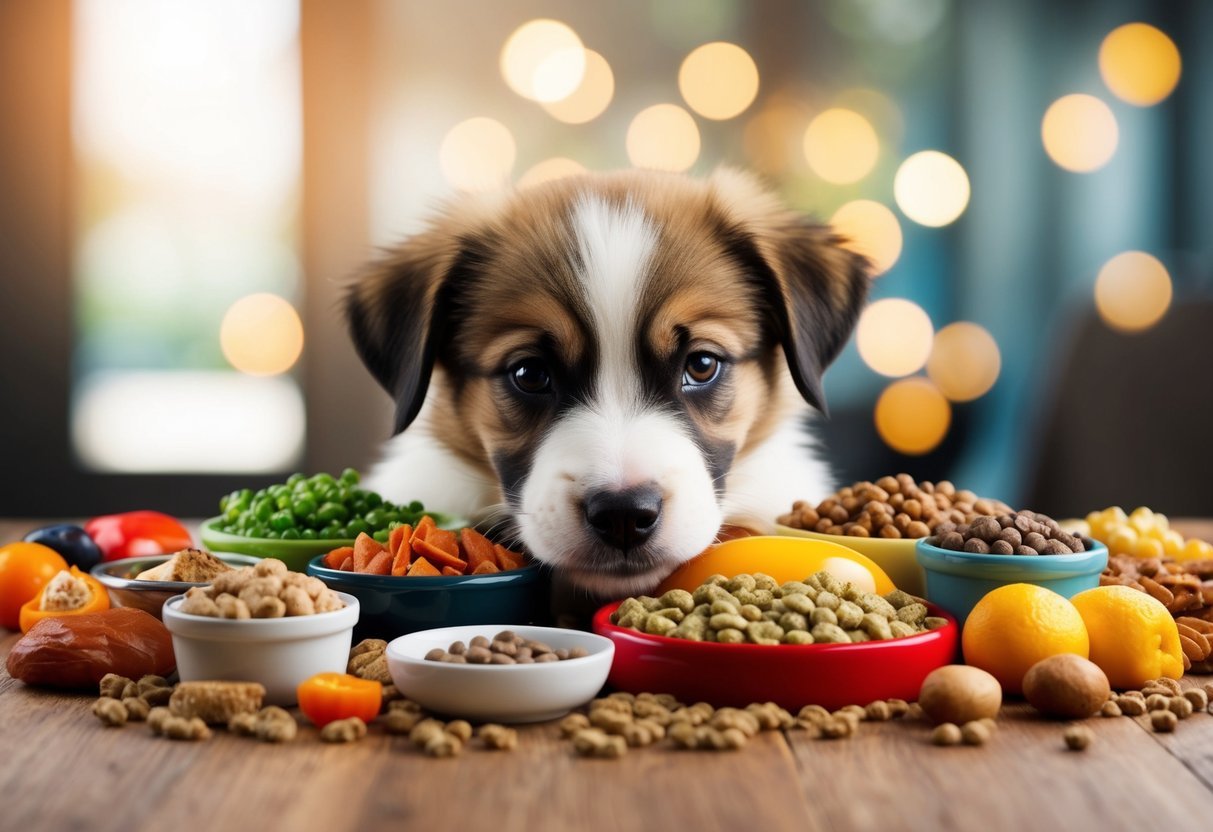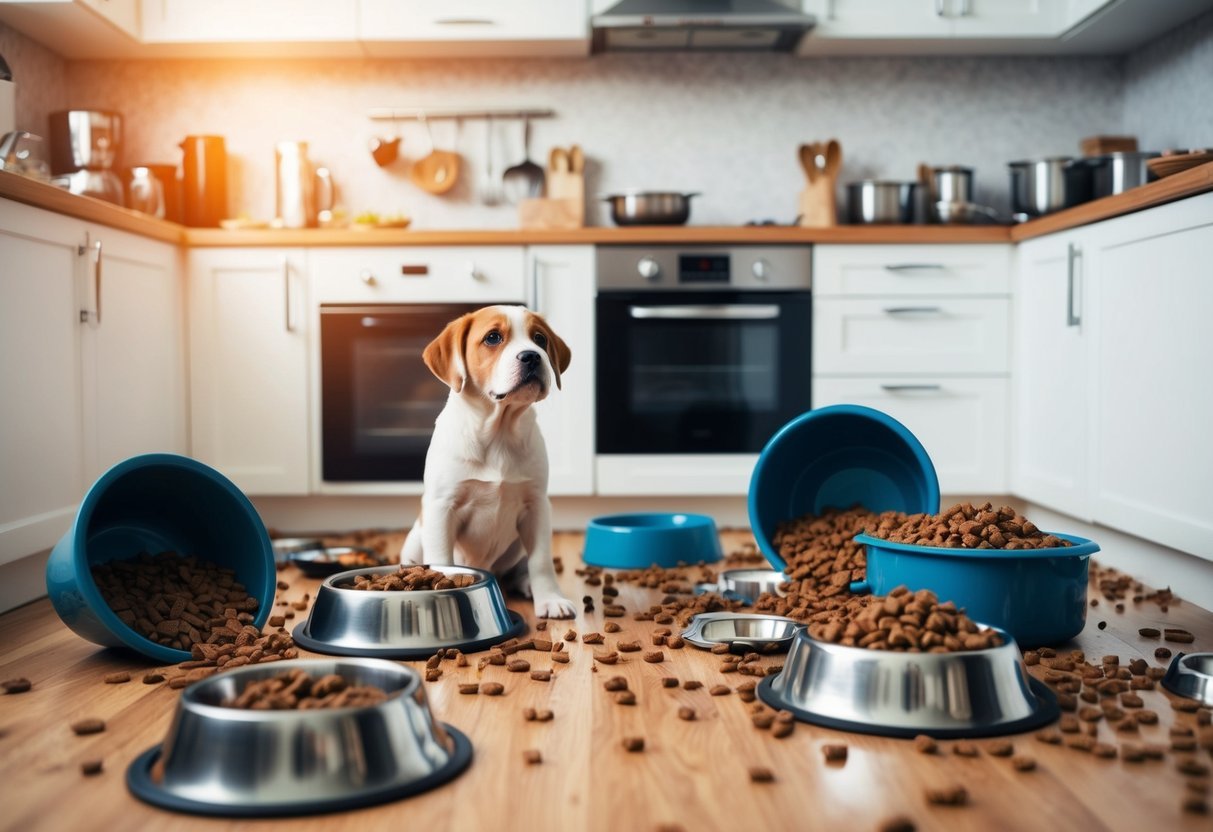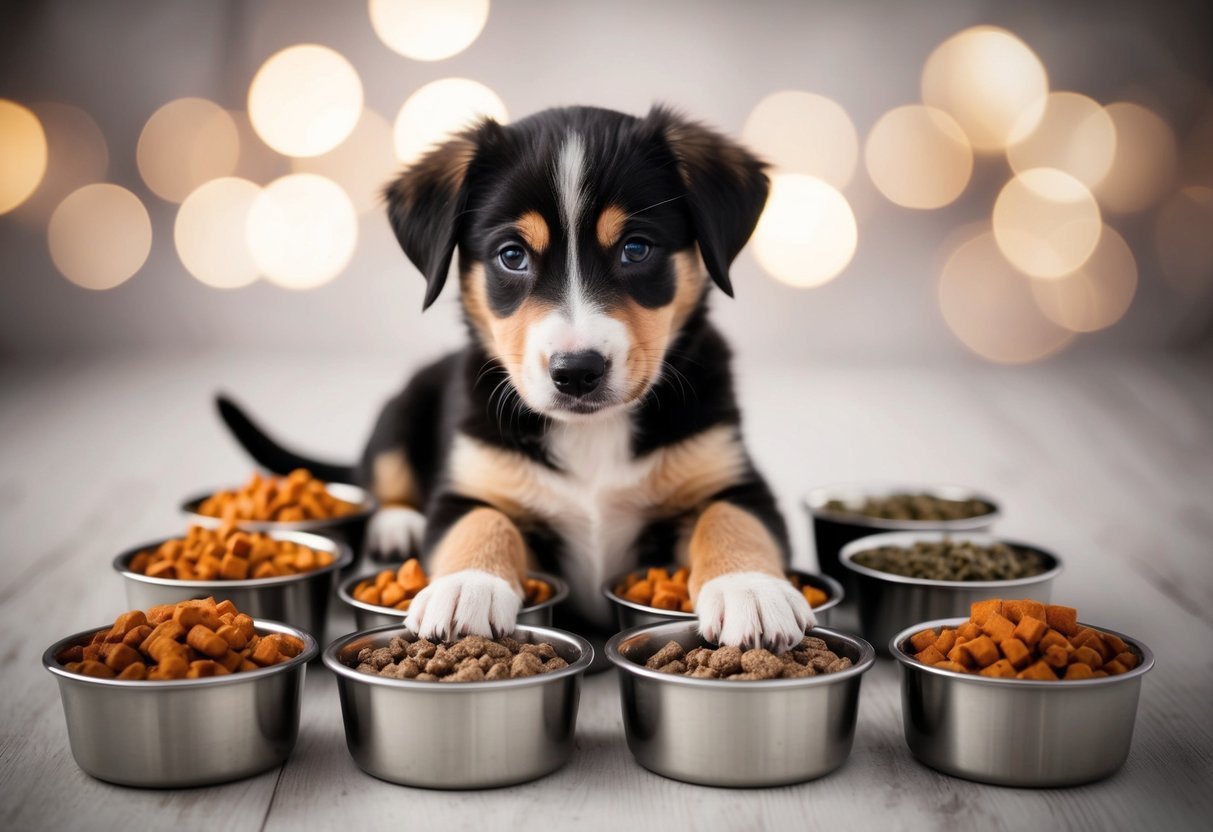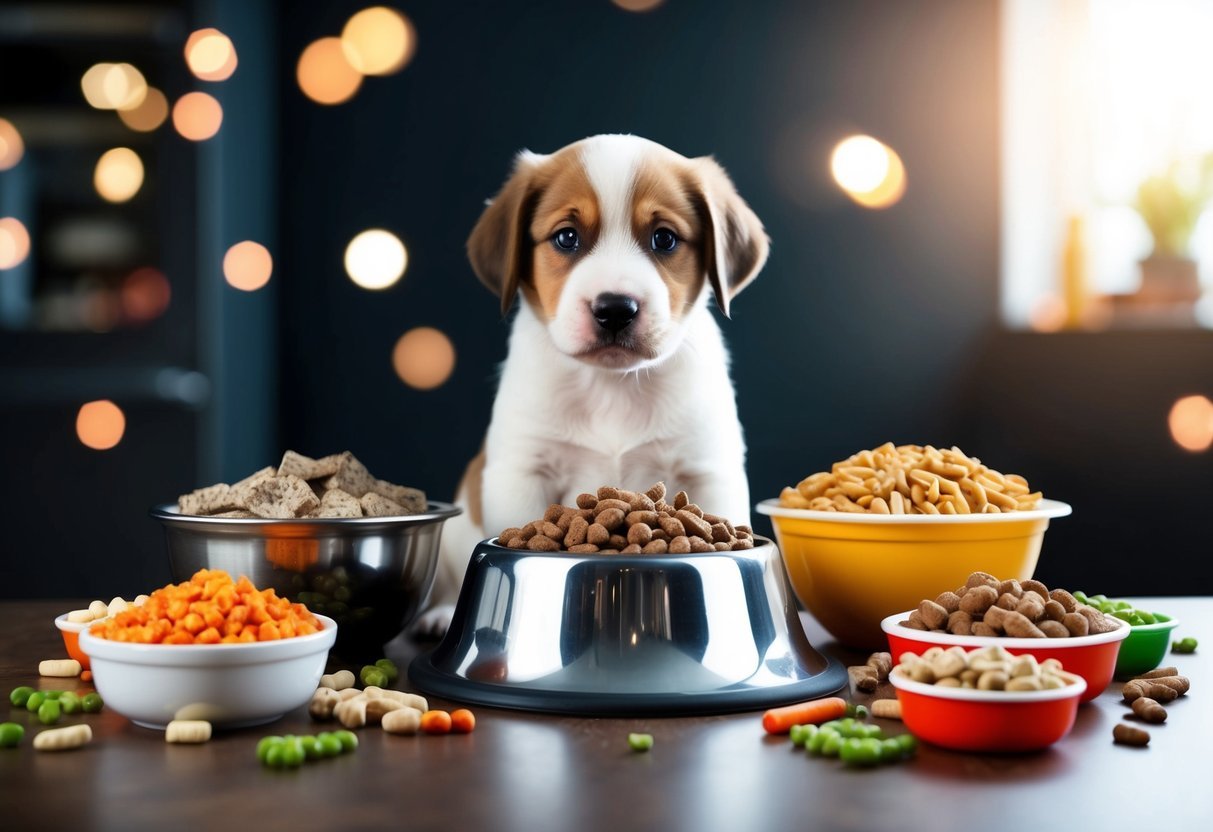Feeding your puppy the right way is crucial for their health and happiness.
Many new dog owners might make mistakes without realizing how these errors can impact their puppy’s growth and well-being. Understanding the common feeding mistakes is essential to ensure your furry friend develops properly and stays healthy.
Your puppy depends on you to provide the best start in life, and that includes their diet.
By avoiding simple yet harmful mistakes in feeding, you can help your pup thrive.
This article will highlight six key feeding errors that every puppy owner should know about to keep their furry family member safe and healthy.
1) Overfeeding your puppy
It’s easy to overfeed your puppy, especially with those big, cute eyes staring up at you.
You might think giving them extra food is showing love, but it can lead to real health issues.
Puppies grow quickly, but that doesn’t mean they need unlimited food.
Overfeeding can cause obesity, which increases the risk of joint problems, heart disease, and even diabetes.
It’s important to feed the right amount based on their age and size.
Look out for signs of overfeeding, like weight gain or lethargy.
If your puppy seems less active or is gaining too much weight, it might be time to adjust their food intake.
Always consult your vet for the best feeding plan.
They can help you establish a schedule and portion sizes that fit your puppy’s needs.
Keeping your puppy at a healthy weight sets the stage for a longer, happier life.
Switching foods too quickly

When you switch your puppy’s food too quickly, it can lead to digestive issues.
Just like people, dogs need time to adjust to new diets.
If you change their food all of a sudden, it might upset their tummy.
A good rule of thumb is to mix a small amount of the new food with the old food.
Start with about 25% new food and 75% old food.
Gradually increase the new food over several days.
This slow transition helps your puppy’s stomach adapt.
Signs that the switch was too fast include vomiting or diarrhea.
If your puppy shows these symptoms, take a step back and slow down the transition.
It’s important to be patient and watch how your puppy reacts.
You want to create a positive experience around mealtime.
By switching foods too quickly, you might end up with a negative association for your puppy.
Stick to a gradual change to help keep their belly happy and healthy.
For more tips on how to switch dog foods, check out this guide on the right way to switch.
3) Feeding table scraps
Feeding your puppy table scraps might seem harmless, but it can lead to some serious problems.
While some human foods are safe, many can upset your pup’s stomach or even be toxic.
When you share your meal, your puppy may start to prefer human food over their own.
This can disrupt their regular eating habits and lead to picky eating later on.
Some table scraps can also pose choking hazards.
Foods like bones are risky and may lead to serious injuries.
Additionally, sharing your food can encourage begging behavior.
Once your puppy learns that begging gets them tasty treats, they will keep trying to get more.
Sticking to a balanced diet specially made for puppies is the best way to keep them healthy.
If you want to treat them, consider dog-safe snacks instead.
Ignoring portion sizes

When it comes to feeding your puppy, portion sizes matter a lot.
It’s easy to pour food into the bowl without thinking about how much your puppy really needs.
Too much food can lead to obesity.
This is more than just a weight issue; it can cause serious health problems down the line.
Your puppy may struggle with joint pain, diabetes, and other conditions if they eat too much.
Each puppy has unique needs based on their size, age, and activity level.
Always check the feeding guidelines on your dog food package.
These are there to help you figure out how much to give.
Using a measuring cup is a smart move.
It can help you avoid the temptation of just eyeballing portions.
This way, you ensure your puppy gets the right amount of food every time.
Remember, a healthy puppy grows into a healthy dog.
Keeping an eye on portion sizes is one of the simplest ways to set them up for a long, happy life.
Skipping scheduled meals

Skipping meals can confuse your puppy and lead to bad habits.
Dogs thrive on routine, and having a set feeding schedule helps them know when to expect food.
When you skip a meal, your puppy might become anxious or overly hungry.
This can lead to overeating later or begging for food at odd times.
Irregular feeding can also mess with their digestion.
If your puppy eats at different times each day, it could cause tummy troubles or make them picky about their food.
Sticking to a regular schedule helps your puppy feel secure.
Aim to feed your puppy at the same times each day to promote good eating habits.
This will ensure they stay healthy and happy.
Skipping meals isn’t just about food; it affects your puppy’s whole routine.
A consistent mealtime can make a big difference in their behavior and well-being.
6) Feeding the same food constantly

Feeding your puppy the same food every day can lead to problems.
Puppies need variety in their diet to get all the nutrients they need.
Sticking to one type of food might not provide balanced nutrition over time.
Changing up their food can help prevent food sensitivities and allergies.
Different proteins and ingredients can benefit their health in various ways.
Also, rotating foods may keep your puppy more interested in their meals.
If the same food is served day after day, they might lose interest.
A new flavor can make mealtime exciting again.
When you switch foods, do it gradually.
Start by mixing the new food with the old one.
This helps your puppy adjust and reduces tummy troubles.
Regularly changing the food helps you adapt to your puppy’s changing needs as they grow.
It’s a simple way to support their health and happiness.
Keeping their diet diverse can lead to a healthier, more energetic puppy.
Understanding a Balanced Diet for Puppies

A balanced diet is crucial for your puppy’s growth and development.
It ensures they get the right combination of nutrients to thrive.
Knowing what your puppy needs can help you make informed choices about their food.
Essential Nutrients for Puppy Growth
Your puppy requires various essential nutrients for healthy growth.
Here’s a breakdown of the most important ones:
-
Protein: This is vital for building muscles and tissues. Look for high-quality meat or fish ingredients in their food.
-
Fats: Healthy fats provide energy and aid in nutrient absorption. Omega-3 and Omega-6 fatty acids are particularly beneficial.
-
Carbohydrates: While protein and fats are essential, carbs are an important energy source. They should come from whole grains or vegetables.
-
Vitamins and Minerals: These support many bodily functions. Vitamins A, D, E, and B-complex are key, along with minerals like calcium and phosphorus for bone health.
-
Water: Always ensure fresh water is available. Staying hydrated aids digestion and overall wellness.
Choosing a puppy food that contains these nutrients in the right proportions is important for their health.
Common Puppy Feeding Mistakes

Feeding your puppy properly is crucial for their health and growth.
Many pet owners make simple mistakes that can lead to significant problems.
Here are two of the most common puppy feeding mistakes you should watch out for.
Overfeeding and Its Effects
Overfeeding is a common mistake that can cause serious health issues in puppies.
Many dog owners may think that giving larger portions or extra meals will help their puppy grow faster.
In reality, this can lead to obesity and joint problems.
Puppies grow quickly, but they don’t need more food than recommended.
Always follow the feeding guidelines on the dog food packaging.
Signs of Overfeeding:
- Weight gain
- Lack of energy
- Difficulty moving around
To keep your pup healthy, monitor their weight regularly.
Adjust portion sizes based on their growth and activity level.
If in doubt, consult your vet for personalized feeding advice.
Feeding Human Foods: What to Avoid
Many pet owners enjoy sharing their meals with their dogs, but not all human foods are safe for puppies.
Some foods may even be toxic.
Avoid feeding puppies foods like chocolate, grapes, onions, and garlic.
These items can cause severe health problems.
Safe Treat Suggestions:
- Carrots
- Apples (remove seeds)
- Blueberries
Stick to treats and kibble designed specifically for dogs.
This ensures your puppy gets the right nutrients without the risk of harmful ingredients.
Always check with your vet when introducing new foods to your puppy’s diet.
Frequently Asked Questions

Puppy feeding can raise many questions.
It’s important to know which foods are safe and which should be avoided to keep your dog healthy.
Below are common questions that many dog owners have.
What human foods are considered dangerous for dogs to consume?
Some human foods can upset your dog’s stomach or even harm them.
Foods like chocolate, grapes, raisins, onions, and garlic are very toxic to dogs.
Keep these items away from your puppy to avoid serious health issues.
Can certain foods be fatal to dogs, and which are the riskiest?
Yes, certain foods can be fatal to dogs.
Chocolate and macadamia nuts are among the riskiest.
Even small amounts can cause severe reactions, so it’s best to never give these foods to your dog.
What are some common toxic foods that dog owners should avoid giving their pets?
In addition to chocolate and grapes, some other toxic foods include avocado, xylitol (found in sugar-free products), and caffeine.
Make sure to read labels and watch what you share with your puppy.
Till what age is it appropriate to feed my dog puppy formula?
Generally, it’s appropriate to feed your dog puppy formula until they are about one year old.
However, larger breeds may need to stay on puppy food longer, sometimes up to 18 months.
Check with your vet for the best advice for your specific breed.
Is it okay for an adult dog to eat food designed for puppies?
Feeding puppy food to adult dogs is not usually recommended.
Puppy food is higher in calories and nutrients.
If your adult dog eats it occasionally, it’s fine, but make it a rare treat.
If my dog eats something harmful, what immediate steps should I take?
If you think your dog has eaten something harmful, act quickly.
Try to identify the substance and contact your vet or an emergency animal clinic.
They may recommend bringing your dog in for treatment or monitoring at home.

